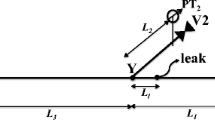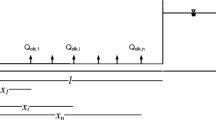Abstract
In this paper, an integrated detection scheme is developed to simultaneously address a leakage, a partial blockage and unknown branched pipeline elements. Expressions for the pressure head and discharge for a branched pipeline system having both a leakage and a blockage are derived in frequency domain. Boundary conditions for a reservoir and a branched dead-end allow the development of impedance formulations. The condition for a pipeline junction can be addressed using either a common condition for the pressure head combined with a continuity condition of discharge or a connectivity condition for impedance. In order to consider the unsteady friction’s impact, the impedance development process studied both the impact resulting from velocity profiles with two-dimensional distributions and the impact resulting from local and convective accelerations. Impedance expressions are derived for two distinct branched pipeline systems at different abnormality conditions. Based on drived formulations describing these systems, response functions were derived in the frequency domain and their corresponding time domain representations were integrated into a meta-heuristic calibration scheme for inverse transient analysis. Using an objective function for minimization of root-mean-square-errors between the observed and computed pressures, the calibration based one impulse response can simultaneously predict locations and magnitudes of abnormalities as well as parameters for a branched pipeline. The strength of the impedance-based approach for inverse transient analysis arises mainly from its feasibility to address different conservation conditions for pressure and discharge and for combining these conditions into a unified impedance connectivity condition.




Similar content being viewed by others
References
Araujo LS, Ramos H, Coelho ST (2006) Pressure control for leakage minimization in water distribution systems management. Water Resour Manag 20(1):133–149
Bergant A, Simpson AR, Vitkovsky J (2001) Developments in unsteady pipe flow friction modeling. J Hydraul Res 39(3):249–257
Boulos PF, Karney BW, Wood DJ, Lingireddy S (2005) Hydraulic transient guidelines for protecting water distribution systems. J Am Water Works Assoc 95(5):111–124
Brunone B, Golia UM, Greco M (1991) Some remarks on the momentum equations for fast transients. Hydraulic transients with column separation (9th and last round table of IAHR Group). IAHR, Valencia, pp 201–209
Chaudhry MH (2013) Applied hydraulic transients. Springer Verlag, London
Duan HF (2015) Uncertainty analysis of transient flow modeling and transient-based leak detection in elastic water pipeline systems. Water Resour Manag 29(14):5413–5427
Duan HF, Lee P (2015) Transient-based frequency domain method for dead-end side branch detection in reservoir-pipeline-valve system. J Hydraul Eng
Duan HF, Lee P, Ghidaoui M, Tung Y (2011) Leak detection in complex series pipelines by using system frequency response method. J Hydraul Res 49(2):213–221
Duan HF, Lee P, Ghidaoui M, Tung Y (2014) Transient wave blockage interaction and extended blockage detection in elastic water pipelines. J Fluids Struct 46:2–16
Ferrante M, Brunone B, Meniconi B, Karney BW, Massari C (2014) Leak size, detectability and test conditions in pressurized pipe systems. Water Resour Manag 28(13):4583–4598
Goldberg DE (1989) Genetic algorithms in search. Optimization and machine learning. Addison-Wesley Publishing Co., Inc., Reading
Gong JZ, Lambert MF, Simpson AR, Zecchin AC (2014) Detection of localized deterioration distributed along single pipelines by reconstructive MOC analysis. J Hydraul Eng 140(2):190–198
Haghighi A, Ramos HM (2012) Detection of leakage freshwater and friction factor calibration in drinking networks using central force optimization. Water Resour Manag 26(8):2347–2363
Kim SH (2005) Extensive development of leak detection algorithm by impulse response method. J Hydraul Eng ASCE 131(3):2001–2007
Kim SH (2008) Address-oriented impedance matrix method for generic calibration of heterogeneous pipe network systems. J Hydraul Eng ASCE 134(1):66–75
Kim SH (2011a) Dynamic memory computation of impedance matrix method. J Hydraul Eng ASCE 137(1):122–128
Kim SH (2011b) Holistic unsteady friction model for the laminar transient flow in pipeline systems. J Hydraul Eng ASCE 137(12):1649–1658
Kim SH, Zecchine A, Choi L (2014) Diagnosis of a pipeline system for transient flow in low reynolds number with impedance method. J Hydraul Eng ASCE 140(12). doi: 10.1061/(ASCE)HY.1943-7900.0000945
Lee PJ, Lambert MF, Simpson AP, Vitkovsky JP (2006) Experimental verification of the frequency response method for pipeline leak detection. J Hydraul Res 44(5):693–707
Liggett JA, Chen L (1994) Inverse transient analysis in pipe networks. J Hydraul Eng ASCE 120(8):934–955
Massari C, Yeh TCJ, Ferrante M, Brunone B, Meniconi S (2015) A stochastic approach for extended partial blockage detection in viscoelastic pipelines: numerical and laboratory experiments. J Water Supply Res Technol AQUA 64(5):583–595
Meniconi S, Brunone B, Ferrante M, Massari C (2011a) Small amplitude sharp pressure waves to diagnostic pipe systems. Water Resour Manag 25(1):79–96
Meniconi S, Brunone B, Ferrante M, Massari C (2011b) Transient tests for locating and sizing illegal branches in pipe systems. J Hydroinf 13(3):334–345
Mpesha W, Gassman SL, Chaudry MH (2001) Leak detection in pipes by frequency response method. J Hydraul Eng ASCE 127(2):134–147
Puust R, Kapelan Z, Savic DA, Koppel T (2010) A review of methods for leakage management in pipe networks. Urban Water J 7(1):25–44
Sattar AM, Chaudhry MH, Kassem AA (2008) Partial blockage detection in pipelines by frequency response method. J Hydraul Eng ASCE 134(1):76–89
Suo L, Wylie EB (1989) Impulse response method for frequency-dependent pipeline transients. J Fluids Eng Trans ASME 111(4):478–483
Wylie EB, Streeter VL (1993) Fluid transient in systems. Prentice Hall, Inc, Englewood Cliffs, p 339
Zielke W (1968) Frequency-dependent friction in transient pipe flow. J Basic Eng ASME 90(1):109–115
Acknowledgments
This research was supported by the Basic Science Program (NRF-2013R1A12058980) through the National Research Foundation of Korea(NRF).This paper was partially supported by Korea Ministry of Environment as “Projects for Developing Eco-Innovation Technologies (GT-11-G-02-001-1)”.
Author information
Authors and Affiliations
Corresponding author
Ethics declarations
Conflicts of Interest
The author declares that he has no conflict of interest.
Rights and permissions
About this article
Cite this article
Kim, S. Impedance Method for Abnormality Detection of a Branched Pipeline System. Water Resour Manage 30, 1101–1115 (2016). https://doi.org/10.1007/s11269-015-1213-6
Received:
Accepted:
Published:
Issue Date:
DOI: https://doi.org/10.1007/s11269-015-1213-6




